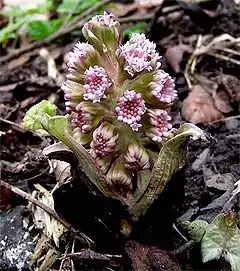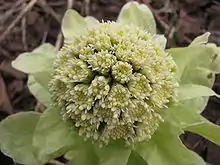Petasites
Petasites is a genus of flowering plants in the sunflower family, Asteraceae, that are commonly referred to as butterburs[2][3][4] and coltsfoots.[5] They are perennial plants with thick, creeping underground rhizomes and large rhubarb-like leaves during the growing season. Most species are native to Asia or southern Europe.
| Petasites | |
|---|---|
 | |
| Petasites hybridus | |
| Scientific classification | |
| Kingdom: | Plantae |
| Clade: | Tracheophytes |
| Clade: | Angiosperms |
| Clade: | Eudicots |
| Clade: | Asterids |
| Order: | Asterales |
| Family: | Asteraceae |
| Subfamily: | Asteroideae |
| Supertribe: | Senecionodae |
| Tribe: | Senecioneae |
| Subtribe: | Tussilagininae |
| Genus: | Petasites Mill. |
| Synonyms[1] | |
| |
Characteristics
The short spikes of flowers are produced just before the leaves in late winter (e.g. Petasites fragrans[2]) or spring, emerging with only a few elongated basal bracts and are usually green, flesh coloured or dull white depending on the species.
Butterbur can be found in parts of Asia such as Korea, China, and Japan, as well as Europe and North America.[6][7] They prefer moist environments such as riverbanks, marshes and ditches.[5][8][9][10]
Petasites is closely related to the genera Tussilago and Senecio.
Medicinal uses
Butterbur has been used for over 2000 years to treat a variety of ailments including fever, lung disease, spasms, and pain.[8] Currently, butterbur extract is used for migraine prevention and treatment of allergic rhinitis, which have the most evidence for its effectiveness.[8][11][12]
Migraine
Some butterbur species contain the chemicals petasin and isopetasin which are believed to have potential benefits in treating migraines.[7] High concentrations of petasin occur in both butterbur root and leaves, with the leaves containing lower levels of the toxic chemical.[13] Butterbur extracts have been reported to be effective in reducing frequency and severity of migraine headaches.[7][8][11][14] Several double-blind studies have shown that high doses of Petasites hybridus" extract, containing petasin and/or isopetasin, are effective both in preventing and in relieving migraine, with the best results in groups taking the higher dose of the supplement.[7][14] Although mainly well tolerated, the adverse effects of butterbur reported in clinical trials include mainly gastrointestinal problems, such as nausea, flatulence, and belching.[15][14] In 2015, the American Academy of Neurology withdrew its original endorsement of butterbur due to safety concerns.[16] However, the Canadian Headache Society still recommends its use in migraine prevention for a selected number of patients based on their clinical features and co-existing disorders.[17]
Hay fever or allergic rhinitis
Additionally, a study showed butterbur extract to be an effective treatment for hay fever without the sedative effect of the antihistamine cetirizine, if taken four times daily.[18] Butterbur was also shown to be comparably effective as fexofenadine when compared to placebo for reducing symptoms of allergic rhinitis.[19]
Risks
Butterbur extracts may contain harmful components called pyrrolizidine alkaloids if the preparations are not carefully and fully purified.[7] The concentration of the toxic alkaloids is often highest in the rhizomes and lowest in the leaves, and may vary depending on where the plants are grown.[13] These chemicals are toxic to the liver and may cause cancers.[20][21] Thus, due to the potential for contamination, taking butterbur supplements is not recommended during pregnancy or breastfeeding.[15] Some sources say it is safe practice to consume butterbur extract that has been prepared by a reputable laboratory.[7] Other sources say no butterbur product is safe: "The cases of liver toxicity appear to have occurred with extracts of butterbur where the pyrrolizidine alkaloids had been removed and only small amounts remained. There is some evidence that other constituents found in butterbur such as the sesquiterpene constituents for example petasin may be implicated in the liver toxicity".[22]
Long-term health effects and interaction of butterbur with other drugs have not been well documented. However, it can theoretically interact with certain blood pressure and heart medications, as well as with drugs that can induce a liver enzyme called CYP3A4 (i.e. St. John's wort, carbamazepine, phenytoin, rifampin); this interaction can potentially lead to increased concentration of the toxic alkaloids.[15]
Species
- Petasites albus – white butterbur – Europe, Algeria, Turkey, Caucasus, India
- Petasites fominii – Republic of Georgia
- Petasites formosanus – Taiwan
- Petasites fragrans (Vill.) C.Presl[24][25]
- Petasites frigidus – Arctic butterbur or Arctic sweet coltsfoot – Scandinavia, Mongolia, Canada, northern USA
- Petasites hybridus – common butterbur – Europe, Mediterranean
- Petasites japonicus – giant butterbur, fuki – China, Japan, Korea
- Petasites kablikianus – southeastern Europe from Poland to Albania
- Petasites kamengicus – Arunachal Pradesh
- Petasites paradoxus – central + southwestern Europe from Spain to Poland
- Petasites pyrenaicus - winter heliotrope - from Azores to Ireland + Tunisia
- Petasites radiatus – Mongolia
- Petasites rubellus – Mongolia, Manchuria, Korea
- Petasites sibiricus – Siberia
- Petasites spurius – Europe, Siberia, Caucasus, Central Asia
- Petasites tatewakianus – Siberia, Russian Far East, northeastern China
- Petasites tricholobus – China, Vietnam, Himalayas
- Petasites versipilus – Sichuan, Yunnan
- Species of hybrid origin[1]
- Petasites × vitifolius
- Species formerly included[1]
Petasites glacialis (Ledeb.) Polunin - Endocellion glaciale (Ledeb.) Toman
References
- Flann, C (ed) 2009+ Global Compositae Checklist Archived 2014-12-11 at Archive.today
- Stace, C. A. (2010). New Flora of the British Isles (Third ed.). Cambridge, U.K.: Cambridge University Press. ISBN 9780521707725.
- Miller, Philip. 1754. Gardeners Dictionary...Abridged...fourth edition page 1056.
- Tropicos, Petasites Mill.
- Petasites. Flora of North America. Volume 20, Page 635. efloras.org.
- "Missouri Botanical Garden".
- Sun-Edelstein, Christina (March 2011). "Alternative Headache Treatments: Nutraceuticals, Behavioral and Physical Treatments". Headache. 51 (3): 469–483. doi:10.1111/j.1526-4610.2011.01846.x. PMID 21352222. S2CID 30412404.
- Sutherland, Anna; Sweet, Burgunda (May 2010). "Butterbur: An alternative therapy for migraine prevention". American Journal of Health-System Pharmacy. 67 (9): 705–711. doi:10.2146/ajhp090136. PMID 20410544.
- Petasites. Flora of China. Volume 20-21, Page 461. efloras.org.
- Altervista Flora Italiana genere Petasites
- "Evidence-based guideline update: NSAIDs and other complementary treatments for episodic migraine prevention in adults. Report of the Quality Standards Subcommittee of the American Academy of Neurology and the American Headache Society". Quality Standards Subcommittee of the American Academy of Neurology and the American Headache Society. Neurology 2012 Apr 24;78(17):1346-53. Archived from the original on 2014-05-04. Retrieved 2012-10-02.
- Kaufeler, Robert; Polasek, Wolfgang; Brattstrom, Axel; Koetter, Uwe (March 2006). "Efficacy and Safety of Butterbur Herbal Extract Ze 339 in Seasonal Allergic Rhinitis: Postmarketing Surveillance Study". Advances in Therapy. 23 (2): 373–384. doi:10.1007/bf02850143. PMID 16751170. S2CID 6597820.
- Taylor, Frederick (March 2011). "Nutraceuticals and Headache: The Biological Basis". Headache. 51 (3): 484–501. doi:10.1111/j.1526-4610.2011.01847.x. PMID 21352223. S2CID 1828681.
- Lipton RB, Göbel H, Einhäupl KM, Wilks K, Mauskop A (December 2004). "Petasites hybridus root (butterbur) is an effective preventive treatment for migraine". Neurology. 63 (12): 2240–4. doi:10.1212/01.wnl.0000147290.68260.11. PMID 15623680. S2CID 10367187.
- "Butterbur". Facts & Comparisons.
- https://n.neurology.org/content/78/17/1346
- Pringsheim, Tamara; Davenport, Jeptha; Mackie, Gordon (March 2012). "Canadian Headache Society Guideline for Migraine Prophylaxis". Canadian Journal of Neurological Sciences. 39 (2): S1–59. PMID 22683887.
- Schapowal, A.Schapowal A; Petasites Study, Group (19 January 2002). "Randomised controlled trial of butterbur and cetirizine for treating seasonal allergic rhinitis". BMJ. 324 (7330): 144–6. doi:10.1136/bmj.324.7330.144. PMC 64514. PMID 11799030.
- Schapowal, Andreas (2005). "Treating Intermittent Allergic Rhinitis: A Prospective, Randomized, Placebo and Antihistamine-controlled Study of Butterbur Extract Ze 339". Phytotherapy Research. 19 (6): 530–537. doi:10.1002/ptr.1705. PMID 16114089. S2CID 38128529.
- Maxim Hirono I., Mori H., Yamada K. "Carcinogenic activity of petasitenine, a new pyrrolizidine alkaloid isolated from Petasites" Journal of the National Cancer Institute 1977 58:4 (1155-1157)
- Smith, LW; Culvenor, CC (1981). "Plant sources of hepatotoxic pyrrolizidine alkaloids". Journal of Natural Products. 44 (2): 129–52. doi:10.1021/np50014a001. PMID 7017073.
- "Search results — The Plant List". theplantlist.org.
- Clapham, A.R., Tutin, T.G. and Warburg. 1968. Excursion Flora of the British Isles. Cambridge University Press. ISBN 0-521-04656-4
- Parnell, J. and Curtis, T. 2012. Webb's An Irish Flora. Cork University Press. ISBN 978-185918-4783
External links
- Flora Europaea: Petasites species list and distributions
- eFloras search results: Petasites
- Edibility of Petasites: Visual identification and edible parts of sweet coltsfoot.
